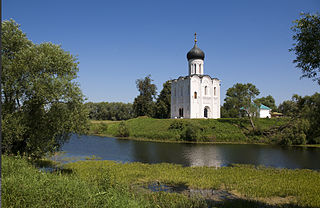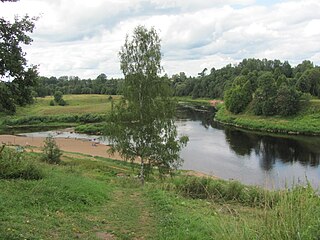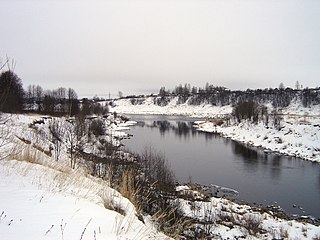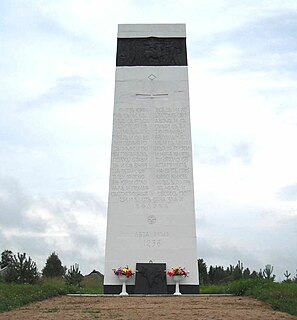Coordinates: 57°6′34.6818″N37°40′2.9562″E / 57.109633833°N 37.667487833°E

A geographic coordinate system is a coordinate system that enables every location on Earth to be specified by a set of numbers, letters or symbols. The coordinates are often chosen such that one of the numbers represents a vertical position and two or three of the numbers represent a horizontal position; alternatively, a geographic position may be expressed in a combined three-dimensional Cartesian vector. A common choice of coordinates is latitude, longitude and elevation. To specify a location on a plane requires a map projection.
| Nerl River | |
|---|---|
The Nerl by the village of Yelpatyevo | |
| Country | Russia |
| Physical characteristics | |
| Main source | Lake Pleshcheyevo |
| River mouth | Volga River (Uglich Reservoir) |
| Length | 112 km (70 mi) [1] |
| Basin features | |
| Basin size | 3,270 km2 (1,260 sq mi) [1] |
The Nerl River (Russian : Нерль) is a river in Pereslavsky District of Yaroslavl and Kalyazinsky District of Tver Oblast in Russia, a right tributary of the Volga River (the Uglich Reservoir). The length of the river is 112 kilometres (70 mi). The area of its drainage basin is 3,270 square kilometres (1,260 sq mi). Its main tributary is the Kubr River (left). [1]

Russian is an East Slavic language, which is official in the Russian Federation, Belarus, Kazakhstan and Kyrgyzstan, as well as being widely used throughout Eastern Europe, the Baltic states, the Caucasus and Central Asia. It was the de facto language of the Soviet Union until its dissolution on 25 December 1991. Although nearly three decades have passed since the breakup of the Soviet Union, Russian is used in official capacity or in public life in all the post-Soviet nation-states, as well as in Israel and Mongolia.

A river is a natural flowing watercourse, usually freshwater, flowing towards an ocean, sea, lake or another river. In some cases a river flows into the ground and becomes dry at the end of its course without reaching another body of water. Small rivers can be referred to using names such as stream, creek, brook, rivulet, and rill. There are no official definitions for the generic term river as applied to geographic features, although in some countries or communities a stream is defined by its size. Many names for small rivers are specific to geographic location; examples are "run" in some parts of the United States, "burn" in Scotland and northeast England, and "beck" in northern England. Sometimes a river is defined as being larger than a creek, but not always: the language is vague.

Pereslavsky District is an administrative and municipal district (raion), one of the seventeen in Yaroslavl Oblast, Russia. It is located in the south of the oblast. The area of the district is 3,130 square kilometers (1,210 sq mi). Its administrative center is the town of Pereslavl-Zalessky. Population: 20,352 ; 22,576 (2002 Census); 27,971 (1989 Census).
It originates in the Lake Pleshcheyevo under the name of Veksa-Pleshcheyevskaya, flows northwest and is known as the Nerl downstream of Lake Somino. Downstream of the village of Andrianovo a stretch of the Nerl makes the border between Yaroslavl and Tver Oblasts. Further downstream, the Nerl enters Tver Oblast. Its mouth is in the village of Sknyatino. The Nerl River freezes up in November and stays under the ice until April.

Lake Pleshcheyevo, a lake in Russia, and formerly a resort for Russian tsars, is located in Yaroslavl Oblast. The town of Pereslavl-Zalessky is on the southeastern side of the lake.
Sknyatino is a village in Kalyazinsky District of Tver Oblast, Russia, situated at the confluence of the Nerl and the Volga Rivers, about halfway between Uglich and Tver. It is the site of the medieval town of Ksnyatin, founded by Yuri Dolgoruki in 1134 and named after his son Constantine. Ksnyatin was intended as a fortress to defend the Nerl waterway, leading to Yuri's residence at Pereslavl-Zalessky, against Novgorodians. The latter sacked it on several occasions, before the Mongols virtually annihilated the settlement in 1239. After that, it belonged to the princes of Tver and was devastated by their enemies in 1288. By the 14th century, the neighbouring towns of Kalyazin and Kashin superseded it in importance. Since 1459, Ksnyatin has been documented as a village. Its kremlin area and cathedral were flooded in 1939, when they created the Uglich Reservoir.
The drainage basin of the Nerl includes the western and the central parts of Pereslavsky District, the southern part of Kalyazinsky District, as well as relatively minor areas in the southern part of Uglichsky District of Yaroslavl Oblast, and northern parts of Alexandrovsky District of Vladimir Oblast and Taldomsky and Sergiyevo-Posadsky Districts of Moscow Oblast. The town of Pereslavl-Zalessky and the urban-type settlement of Kubrinsk lie in the drainage basin of the Nerl.

Uglichsky District is an administrative and municipal district (raion), one of the seventeen in Yaroslavl Oblast, Russia. It is located in the southwest of the oblast. The area of the district is 2,568 square kilometers (992 sq mi). Its administrative center is the town of Uglich. Population: 13,255 ; 15,540 (2002 Census); 18,069 (1989 Census).

Alexandrovsky District is an administrative and municipal district (raion), one of the sixteen in Vladimir Oblast, Russia. It is located in the west of the oblast. The area of the district is 1,834 square kilometers (708 sq mi). Its administrative center is the town of Alexandrov. Population: 113,900 (2010 Census); 55,207 ; 26,258 (1989 Census). The population of Alexandrov accounts for 54.0% of the total district's population.

Vladimir Oblast is a federal subject of Russia. Its administrative center is the city of Vladimir, which is located 190 kilometers (120 mi) east of Moscow. As of the 2010 Census, the oblast's population was 1,443,693.
















